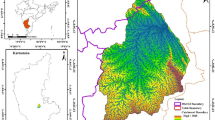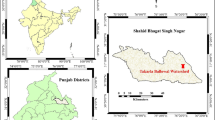Abstract
Morphometric analysis is essential for determining soil erosion-prone areas in drainage basins. In the present study, identification and prioritization of 19 watersheds in the Upper Bhima basin was done using areal, shape, and landscape parameters of watersheds. Some uncertainty was observed with morphometric variables of watersheds in previous prioritization methods. A geographic information system was used to identify critical sub-watersheds in the study area. A newly developed weighted sum approach technique was used to rank each sub-watershed based on weightages derived from morphometric parameters. The 19 watersheds were classified into five categories based on their final priority ranking: very high, high, medium, low, and very low. According to the findings of this analysis, 30.00% of the total area was highly vulnerable with sub-watersheds (4D7H4, 4D7H5, 4D7H7, 4D7G4, 4D7G7) require immediate attention to provide soil and water conservation measures. This study proposed morphometric analysis with a geographic information system and the novel weighted sum approach technique to help decision-makers make technically and economically effective decisions for proper water resource planning and management.






Similar content being viewed by others
Availability of data and materials
The data and material used in the study are from public domain.
Abbreviations
- A :
-
Area
- AISLUS:
-
All India Soil and Land Use Survey
- C c :
-
Compactness coefficient
- C cm :
-
Constant of channel maintenance
- CF:
-
Compound factor
- D d :
-
Drainage density
- DEM:
-
Digital elevation model
- FPR:
-
Final priority ranking
- F f :
-
Form factor
- F s :
-
Stream frequency
- G :
-
Slope
- GIS:
-
Geographic information system
- H max :
-
Maximum height
- H mean :
-
Mean height
- H min :
-
Minimum height
- HI:
-
Hypsometric integral
- km2 :
-
Kilometer square
- L b :
-
Basin length
- Lof :
-
Length of overland flow
- LULC:
-
Land use land cover
- L s :
-
Stream length
- Mha:
-
Million hectare
- MUSLE:
-
Modified Universal Soil Loss Equation
- N :
-
Stream order
- NIH:
-
National Institute of Hydrology
- N s :
-
Number of streams
- P :
-
Perimeter
- PR:
-
Priority ranking
- R :
-
Basin relief
- R b :
-
Bifurcation ratio
- R bm :
-
Mean bifurcation ratio
- R c :
-
Circulatory ratio
- R e :
-
Elongation ratio
- R G :
-
Ruggedness index
- R N :
-
Ruggedness number
- R pk :
-
Relief peakedness
- R r :
-
Relief ratio
- R rf :
-
Relative relief
- RS:
-
Remote sensing
- R t :
-
Texture ratio
- RUSLE:
-
Revised Universal Soil Loss Equation
- SYI:
-
Sediment yield index
- TIFF:
-
Tagged Image File Format
- USLE:
-
Universal Soil Loss Equation
- UTM:
-
Universal Transverse Mercator
- WGS:
-
Word Geographic System
- WSA:
-
Weighted sum approach
References
Agarwal R, Garg RD, Garg PK (2011) Morphometric analysis and prioritization of sub-watersheds in the Loni watersheds, Uttar Pradesh using spatial information technology. J Indian Water Resour Soc 31:19–27
Aher PD, Adinarayana J, Gorantiwar SD (2014) Quantification of morphometric characterization and prioritization for management planning in semi-arid tropics of India: a remote sensing and GIS approach. J Hydrol 511:850–860. https://doi.org/10.1016/j.jhydrol.2014.02.028
All India Soil and Land Use Survey (AISLUS) (1991) Methodology of priority delineation survey.
Arabameri A, Tiefenbacher JP, Blaschke T, Pradhan B, Tien BD (2020) Morphometric analysis for soil erosion susceptibility mapping using novel gis-based ensemble model. Remote Sensing 12(5):874. https://doi.org/10.3390/rs12050874
Balasubramanian A, Duraisamy K, Thirumalaisamy S, Krishnaraj S, Yatheendradasan RK (2017) Prioritization of subwatersheds based on quantitative morphometric analysis in lower bhavani basin, Tamil Nadu, India using DEM and GIS techniques. Arab J Geosci 10(24):552. https://doi.org/10.1007/s12517-017-3312-6
Bali YP, Karale RL (1977) A sediment yield index as a criteria for choosing priority basins. IAHS-AISH Publication, pp 122–180
Benzougagh B, Meshram SG, Dridri A, Boudad A, Baamar B, Sadkaoui D, Khedher KM (2021) Identification of critical watershed at risk of soil erosion using morphometric and geographic information system analysis. Appl Water Sci 12:8. https://doi.org/10.1007/s13201-021-01532-z
Bhattacharya RK, Chatterjee ND, Das K (2020) Sub-basin prioritization for assessment of soil erosion susceptibility in Kangsabati, a plateau basin A comparison between MCDM and SWAT models. Sci Total Environ 734:139474. https://doi.org/10.1016/j.scitotenv.2020.139747
Central Water Commission (CWC) (2012) Watershed and Reservoir Sedimentation Directorate. Capacity assessment of Bhima (Ujjani) reservoir
Central Water Commission (CWC) (2015) Compendium of silting of reservoirs in India
Central Water Power Research Station (2010) Optimization of stream gauge and raingauge network for Upper Bhima Basin
Citlalli CA, Armando LS, Jose MZV (2021) Mapping risk zones of potential erosions in the upper Nazas River basin, Mexico through spatial autocorrelation techniques. Environ Earth Sci 80:653. https://doi.org/10.1007/s12665-021-09956-1
Gajbhiye S, Mishra SK, Pandey A (2014) Prioritizing erosion-prone area through morphometric analysis. An RS and GIS perspective. Appl Water Sci 4(1):51–61. https://doi.org/10.1007/s13201-013-0129-7
Ganasri BP, Ramesh H (2016) Assessment of soil erosion by RUSLE model using remote sensing and GIS-A case study of Nethravathi Basin. Geosci Front 7(6):953–961. https://doi.org/10.1016/j.gsf.2015.10.007
Hembram TK, Shah S (2018) Prioritization of sub watersheds for soil erosion based on morphometric attributes using fuzzy AHP and compound factor in Jainti River basin, Jharkhand, Eastern India. Environ Dev Sustain. https://doi.org/10.1016/s10668-018-0247-3
Horton RE (1932) Drainage-basin characteristics. Trans Am Geophys Union 13:350–361
Horton RE (1945) Erosional development of streams and their drainage basins; hydrophysical approach to quantitative morphology. Geol Soc Am Bull 56:275
Javarayigowda NH, Basavaraju GKS, Jayaram SH (2018) Morphometric analysis of Karadya micro watershed: a case study of Mandya district. Am J Remote Sens 6(1):15–22
Javed A, Khanday MY, Ahmed R (2009) Prioritization of sub watersheds based on morphometric and land use analysis using remote sensing and GIS techniques. J Indian Soc Remote Sens 37:261–274
Kadam AK, Jaweed TH, Kale SS, Umrikar BN, Sankhua RN (2019) Identification of erosion-prone areas using modified morphometric prioritization method and sediment production rate: a remote sensing and GIS approach. Geomat Nat Haz Risk 10(1):986–1006. https://doi.org/10.1080/19475705.2018.1555189
Kandpal H, Kumar A, Reddy CP, Malik A (2017) Watershed prioritization based on morphometric parameters using remote sensing and geographical information system. Indian J Ecol 44(3):433–437
Kumar D, Dhaloiya A, Nain AS, Sharma MP, Singh A (2021) Prioritization of watershed using remote sensing and geographic information system. Sustainability 13(16):9456. https://doi.org/10.3390/su13169456
Malik A, Kumar A, Kandpal H (2019) Morphometric analysis and prioritization of sub-watersheds in a hilly watershed using weighted sum approach. Arab J Geosci 12(4):118. https://doi.org/10.1007/s12517-019-4310-7
Melton MA (1957) An analysis of the relations among elements of climate, surface properties, and geomorphology. DTIC Document
Meshram SG, Sepheri M, Meshram C, Moatamed A, Benzougagh B, Parvizi S, Bazrafshan E, Rahimi Y (2022) Prioritization of watersheds based on a picture fuzzy analytic hierarchy process and linear assignment model. Stoch Env Res Risk Assess. https://doi.org/10.1007/s00477-022-02280-5
Miller VC (1953) A Quantitative geomorphic study of drainage basin characteristics in the Clinch Mountain area Virginia and Tennessee. J Geol 65(1):112–113
Nanda AM, Hamid A, Hassan Z, Ahmed P, Kanth TA (2015) Watershed prioritization using sediment yield index model for Vishav watershed of Jammu and Kashmir state (India). J Himalayan Ecol Sustain Dev 10:87–94
Naqvi HR, Athick AMA, Ganaie HA, Siddiqui MA (2015) Soil erosion planning using sediment yield index method in the Nun Nadi watershed, India. Int Soil Water Conserv Res 3(2):86–96. https://doi.org/10.1016/j.iswcr.2015.06.007
National Institute of Hydrology (NIH) (2000) Watershed prioritization of Ukai dam catchment using Remote sensing and GIS National Remote Sensing Centre, India, Bhuvan Web Portal. http://bhuvan.nrsc.gov.in
Negash DA, Moisa MB, Merga BB, Sedeta F, Gemeda DO (2021) Soil erosion risk assessment for prioritization of sub-watershed: the case of Chogo watershed, Horo Guduru Wollega, Ethiopia. Environ Earth Sci 80:589. https://doi.org/10.1007/s12665-021-09901-2
Pawar AD, Sarup J, Mittal SK (2014) Application of GIS and RS for morphometric analysis of upper Bhima basin: a case study. J Inst Eng (india) 95(4):249–257. https://doi.org/10.1007/s40030-014-0097-4
Rahamati O, Samadi M, Sahabi H, Azareh A, Sardooi ER, Alilou H, Melesse AM, Pradhan B, Chapi K, Shirzadi A (2019) SWPT: an automated GIS based tool for prioritization of sub watersheds based on morphometric and topo hydrological factors. Geosci Front. https://doi.org/10.1016/j.gsf.2019.03.009
Ratnam KN, Srivastava YK, Rao VV, Amminedu E, Murthy KSR (2005) Check dam position of micro watersheds using SYI model and morphometric analysis-remote sensing and GIS perspective. J Indian Soc Remote Sens 33(1):26–38
Renard KG, Foster GR, Weesies GA, Porter JP (1991) RUSLE: revised universal soil loss equation. J Soil Water Conserv 46(1):30–33
Said E (2021) GIS-based land susceptibility assessment for check dam site location, using topography and drainage information: a case study from Morocco. Environ Earth Sci 80:567. https://doi.org/10.1007/s12665-021-09881-3
Schumm SA (1956) Evolution of drainage systems and slopes in badlands at Perth Amboy. New Jersey. Geol Soc Am Bull 67:597–646
Singh WR, Barman S, Tirkey G (2021) Morphometric analysis and watershed prioritization in relation to soil erosion in Dudhnai watershed. Appl Water Sci 11(9):1–12. https://doi.org/10.1007/s13201-021-01483-5
Smith K (1950) Standards for grading textures of erosional topography. Am J Sci 248:655–668
Strahler AN (1952) Hypsometric (area-altitude) analysis of erosional topography. Geol Soc Am Bull 63:1117–1142
Strahler AN (1957) Quantitative analysis of watershed geomorphology. Trans Am Geophys Union 38(6):913–920
Strahler AN (1964) Quantitative geomorphology of drainage basins and channel networks. In: Chow VT (ed) Handbook of applied hydrology. Sect ion 4–11. McGraw-Hill, New York
Subyani AM, Qari MH, Matsah MI (2012) Digital elevation model and multivariate statistical analysis of morphometric parameters of some wadis, western Saudi Arabia. Arab J Geosci 5(1):147–157. https://doi.org/10.1007/s12517-010-0149-7
Wagh S, Manekar V (2021) Assessment of reservoir sedimentation using satellite remote sensing technique (SRS). J Inst Eng (india) 102(3):851–860. https://doi.org/10.1007/s40030-021-00539-8
Wagh S, Manekar V (2022) Soil erosion planning for reservoir watershed using sediment yield index method. J Inst Eng (india). https://doi.org/10.1007/s40030-022-00679-5
Williams JR (1975) Sediment routing for agricultural watersheds. JAWRA J Am Water Resour Assoc 11(5):965–974
Wischmeier WH, Smith DD (1965) Predicting rainfall-erosion losses from cropland east of the Rocky Mountains: guide for selection of practices for soil and water conservation No. 282. Agricultural Research Service, US Department of Agriculture
Acknowledgements
The authors are thankful to the Department of Civil Engineering, Sardar Vallabhbhai National Institute of Technology, Surat, India for providing computer and internet facility for carrying out this study.
Funding
This study received no external funding.
Author information
Authors and Affiliations
Contributions
SW was involved in the literature review, methodology, data analysis, results and discussion section. VM supervised this study and involved in writing this manuscript.
Corresponding author
Ethics declarations
Competing interests
The authors declare no competing interests.
Conflict of interest
The authors declare no competing interests.
Additional information
Publisher's Note
Springer Nature remains neutral with regard to jurisdictional claims in published maps and institutional affiliations.
Rights and permissions
Springer Nature or its licensor (e.g. a society or other partner) holds exclusive rights to this article under a publishing agreement with the author(s) or other rightsholder(s); author self-archiving of the accepted manuscript version of this article is solely governed by the terms of such publishing agreement and applicable law.
About this article
Cite this article
Wagh, S., Manekar, V. A GIS-based morphometric prioritization of watersheds for soil erosion planning: a case study. Environ Earth Sci 82, 443 (2023). https://doi.org/10.1007/s12665-023-11155-z
Received:
Accepted:
Published:
DOI: https://doi.org/10.1007/s12665-023-11155-z




